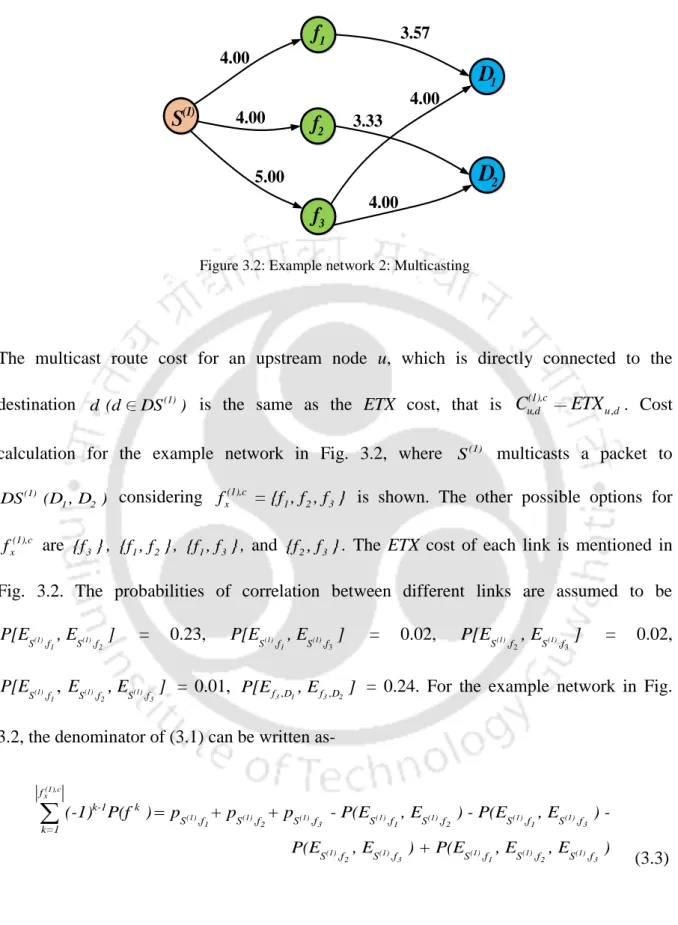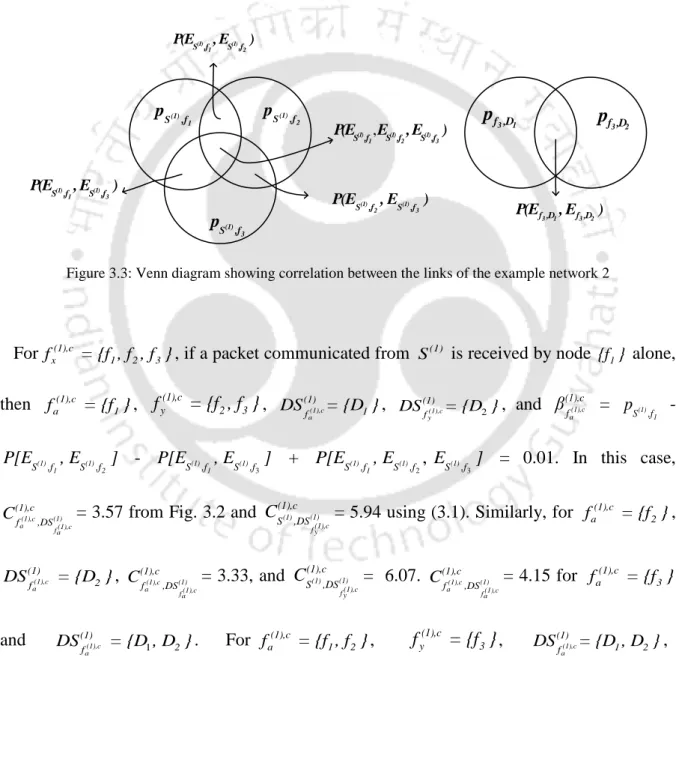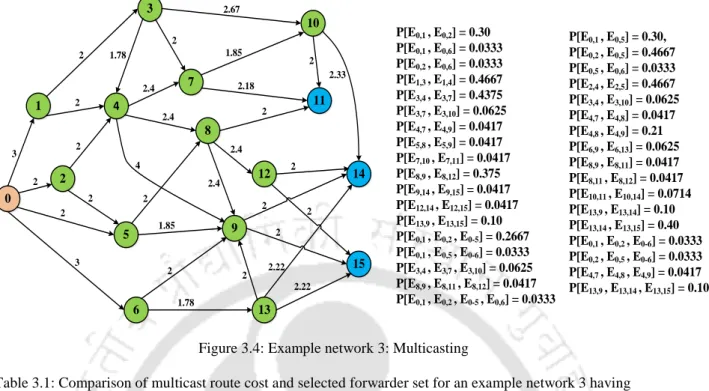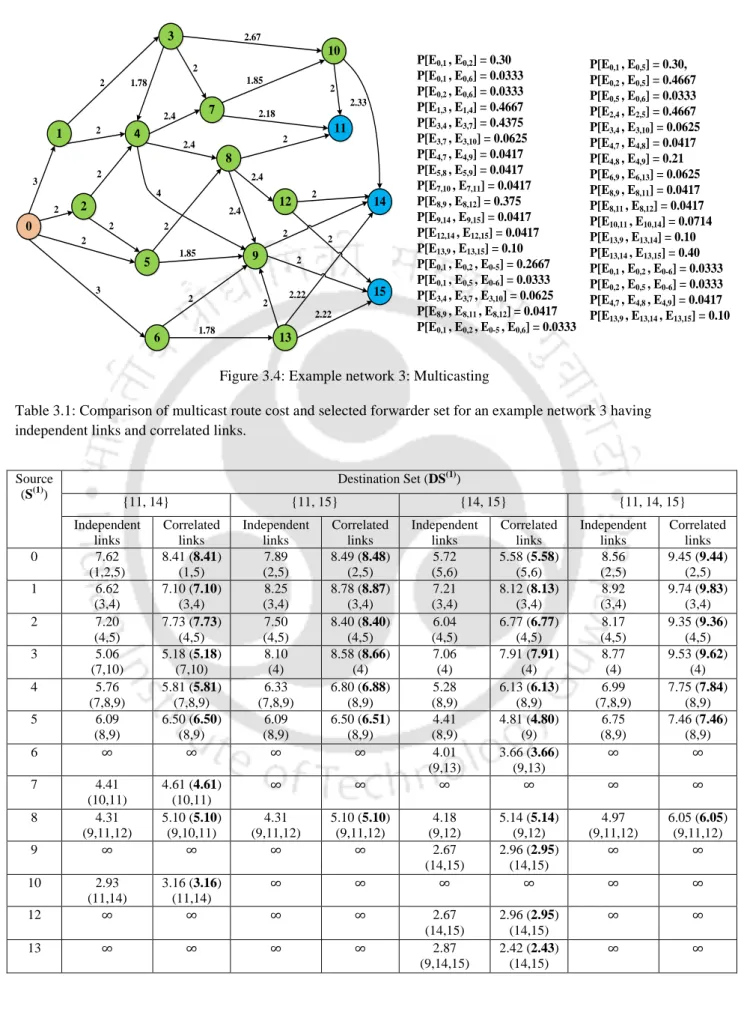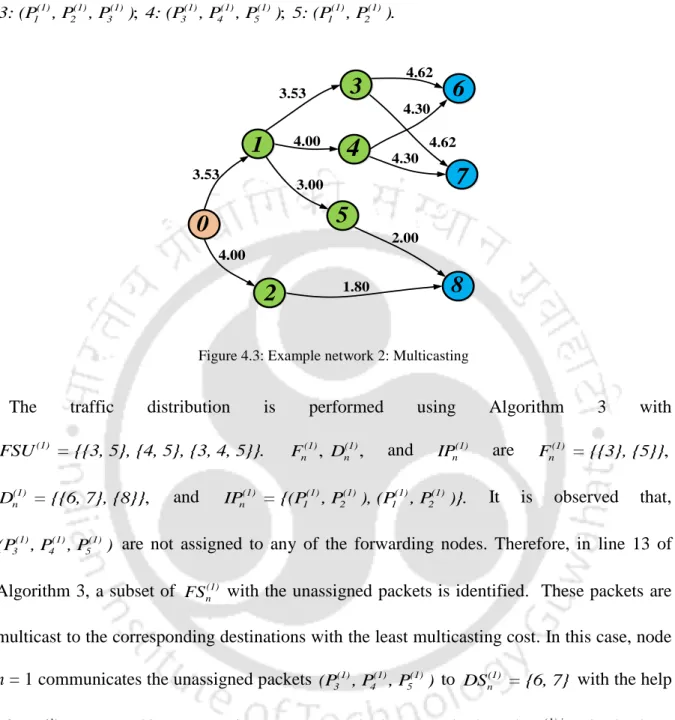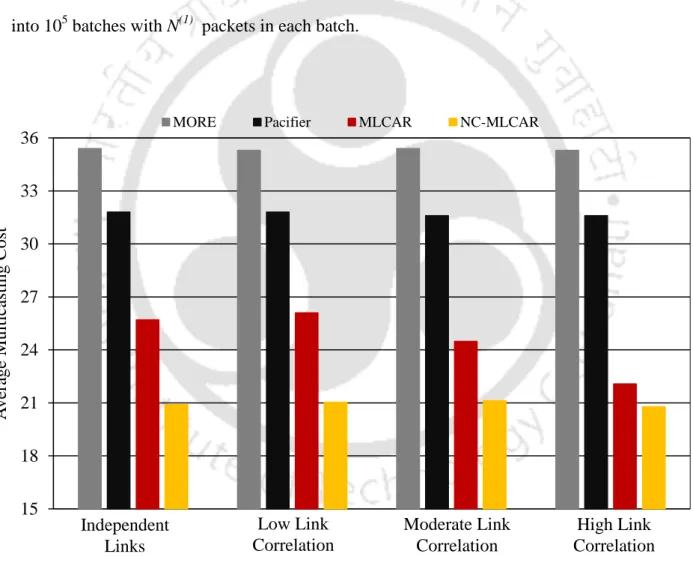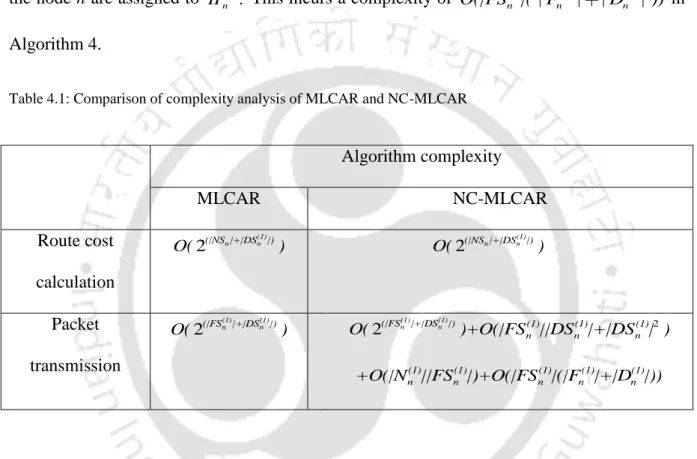Special thanks to my friends from IITG, Birjit, Achyut, Aditya, Nishant, Ashish, Vishal, Sunil, Tushar, Dipanker, Subhashish, Niladri and other M.Sc. Tech., and Ph.D. Last but not least, I would like to express my deepest gratitude, love and affection to my parents and younger brother who have supported me throughout the long journey of my academic pursuits and endured countless sacrifices.
Abstract
Detailed simulation results are presented for both cases when the packets received over the different links are independent or correlated. A significant reduction is found in the overall transmission cost of the proposed scheme for both correlated and independent switching networks.
Contents
List of Tables
List of Symbols
ENE(q) set of subsets of FSn( )q which must receive all innovative packets of q. Ncw number of innovative packets present in CW node IPCWn innovative packets present in CW node n.
List of Abbreviations
Introduction
- Wireless Correlated Links
- Network Coding
- Reliable and Unreliable Multicast
- Motivation and Research Objectives
- Thesis Outline and Contributions
Network Coding (NC) can then use this to improve overall performance and delay network performance. ACKs and NACKs are used to ensure reliable delivery of all packets to each destination group member.
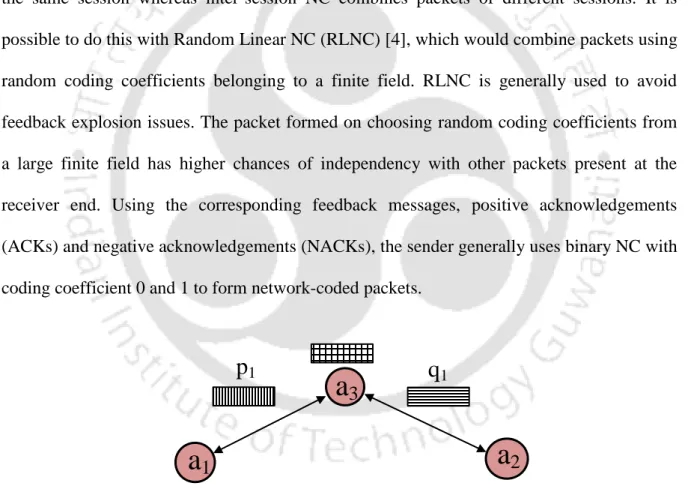
Literature Survey: Review of Related Work
- Wireless Networks with Correlated Links
- Reliable Multicast in Wireless Networks
- Unreliable Multicast in Wireless Networks
- Multi-Source Multicast in Wireless Networks
- Summary
In order to improve network performance, the authors in [34] and [35] proposed scheduling techniques that carefully implement interference-free multicast transmission using RLNC over multi-hop wireless networks. Multicast using intra-session NC in a multi-rate, multi-channel scenario is discussed in [40], where the authors proposed an optimization model to improve network throughput at the cost of increased network resource utilization. The performance of multicasting in wireless networks generally depends on whether they can reach destinations with poorer connections from the source.
In [66], authors have presented multi-rate multicasting to improve the throughput of multi-hop wireless network. When the D2D method is selected, one of the users is selected as the source to send a network encoded packet to the other users. This scheduling scheme combines the effect of multicasting and D2D communication to improve the overall throughput of the network.
Using the packet reception reports from the destination nodes, the relay node broadcasts a new encoded packet between sessions to improve the overall system performance. NC scheme for multi-source multicasting which improves network throughput using intra-session and inter-session NC is proposed in [92]. Intra-session NC increases the multicasting efficiency of a session, and inter-session NC improves the overall throughput of the network.
Multicasting in Wireless Networks with Correlated Links
- Introduction
- Multicasting Route Cost Calculation with Correlated Links
- Packet Transmission Strategy
- Multicasting with Correlated Links: Example
- Summary
The links of a network are considered highly correlated if the receiving nodes have a higher chance of successfully receiving the packet in the same transmission. When links have low correlation, the probability of the packet traversing the links correctly in the same transmission will be low. When wireless broadcasting is used and node S(1) broadcasts a packet, it is possible for the packet to be received by one or both of the two destination nodes D1 or D2.
If the packet does not reach either destination D1 or D2, then node S(1) must resend the packet. The probability of correlation between L links is defined as the probability of the event when the packet is successfully received at all the L nodes simultaneously, and is represented as Here fk is subset of fx(1),c with size k and P(f)k is probability that k nodes of fx(1),c successfully receive the packet and communicate ACK to the source.
This helps in packet transmission through a least cost path in the network and gives us the number of transmissions required for successful reception of the packet by the nodes in DS(1). The source node broadcasts a packet until forwarding nodes that can reach all destinations receive the packet successfully. If, during this process, the packet is successfully received by some of the forwarding nodes that can reach the subset of DS(1), then they discard further reception and the packet is targeted to forwarding nodes that cover the remaining destinations.
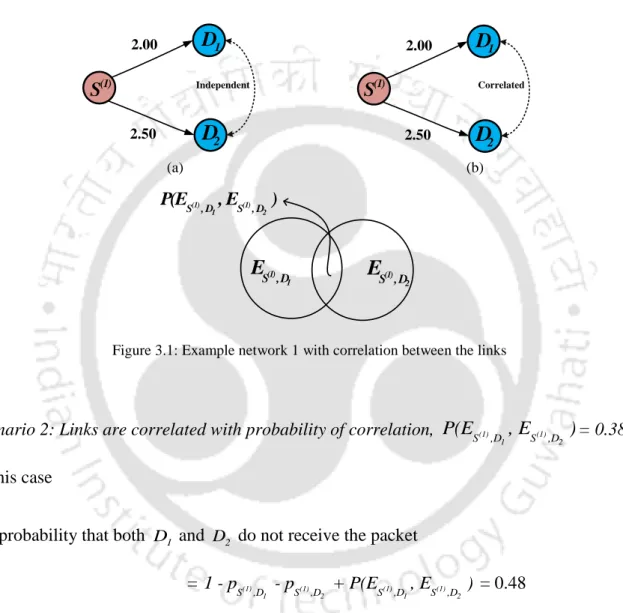
Network Coding Assisted Reliable Multicasting in Multi-Hop Wireless Networks
- Introduction
- Packet Transmission
- Traffic Distribution
- Initialization
- Simulation Results and Complexity Analysis
- Summary
The probability that the packet is not received at any of the nodes in fx(1),i is given by PF. Nodes of FSn(1) in Algorithm 4 act as the new source to forward the assigned packets to their corresponding destination set. In this section, simulation results and complexity analysis for the proposed NC-MLCAR scheme are presented.
The multicasting cost of the scheme is compared with the other state-of-the-art schemes such as MEER [4], Pacifier [7] and MLCAR [5] for both independent and correlated switching networks. In correlated link networks, the probability of correlation between links of the network depends on pS. It is observed that the average multicasting cost of the proposed NC-MLCAR scheme is significantly lower than that of the MORE, Pacifier and MLCAR protocols.
Moreover, the average multicasting cost of MORE, Pacifier, and NC-MLCAR is almost constant under varying link correlation. Simulation results show the advantages of the proposed NC-MLCAR scheme over existing NC-assisted multicasting approaches such as MORE [4] and Pacifier [7]. The multicasting cost of the NC-MLCAR scheme is almost constant under changing link correlation.
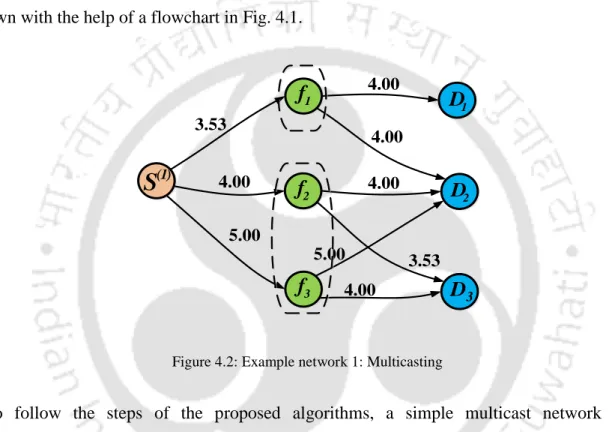
Network Coding Assisted Reliable Multi-Source Multicasting in Multi-Hop Wireless Networks
Introduction
Results and complexity analysis of the NCRMM scheme are presented and compared with the corresponding MLCAR and NC-MLCAR schemes. It is assumed that the source node does not act as an intermediate network node. In the proposed scheme, the least cost multicast path is obtained using the MLCAR protocol [5].
Let B(q) be a batch for the qth session consisting of N(q) packets. P) The packets in a batch of the qth session are stored in the forwarding node's queue after the packet forwarding decision is made based on the MLCAR cost. If the CW is not empty and packets have already been assigned to nodes for transmission, they are stored in the node's queue. A network encoded packet formed by combining PC packets can be decoded if the receiver has P-1C of the PC packets in its queue.
A destination of the qth session can reclaim the cluster once it receives all N(q) innovative packets of the cluster. In the proposed scheme, FS (q) is selected among neighboring nodes so that the cost for DS(q) is minimal. The values of ps are assumed to be the same for bidirectional links in the network.
- Proposed Algorithm: NCRMM
- Simulation Results and Complexity Analysis
- Simulation Results of TSMNC
- Simulation Results of NCRMM
- Complexity Analysis
- Summary
In Algorithm 3, packet distribution based on multicasting cost is done between nodes of the forwarder set. These forwarding nodes ( f 'su ) can act as forwarding nodes for other source nodes of the network. In this subsection, the multicasting cost of the TSMNC scheme is compared with that of the MLCAR protocol [5].
5.4, the average multicasting costs of the 10 random networks are plotted for TSMNC and MLCAR schemes. It is noted that the multicasting cost of the TSMNC scheme is significantly smaller than that of the MLCAR protocol. The average multicasting cost of the NCRMM scheme is lower than that of the MLCAR and NC-MLCAR protocols.
The N(q) innovative packets in ENE(q) for the qth multicast session is O(|M | ),n(q)2, where Mn(q) is the size of the target set belonging to the qth session. Network-coded packets are formed using the packet reception status of innovative Ncw packets sent to EFSN nodes, resulting in a complexity of O(|Ncw||EFSN )| where Ncw is the number of packets present in the CW. O( |FS |(|F |+|D |) ) The complexity analysis of the proposed NCRMM scheme is tabulated along with that of the MLCAR and NC-MLCAR schemes.
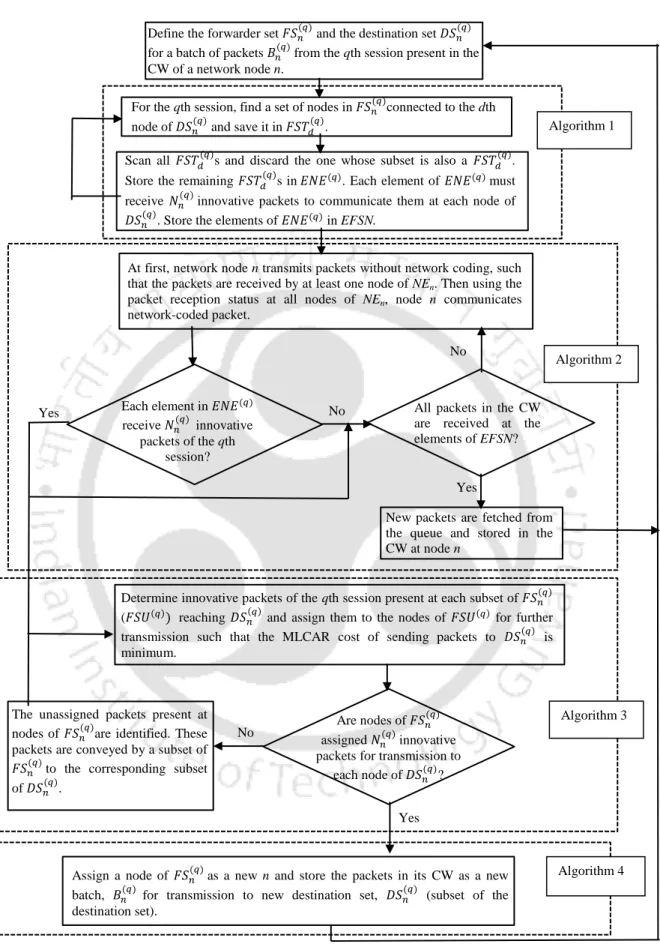
Conclusions and Future Scopes
Conclusions
The packet reception status is tracked using ACK/NACK, which ensures that all innovative packets are forwarded to the successive nodes and finally reach the set destination. Multi-source multicasting is an emerging topic due to the enormous demand for applications where customers request services such as billing information, medical images and new software updates. The MLCAR protocol provides the lowest multicasting costs and the associated route.
The MLCAR protocol is used to determine the multicasting cost and the forwarder set for each of the sessions. Source node performs batch communication and multicast packets to the respective forwarding nodes using intra-session NC. The packet reception status at the neighboring nodes is communicated using ACK/NACK, which ensures that the innovative packets from all the multicasting sessions are sent to the forwarding nodes, which then forward them to the sender.
In this thesis, the forwarder set selection is made using the MLCAR protocol as it provides the least multicasting cost from source to the destination set, although the complexity for costing and forwarder system selection will increase as the destination set size increases. Therefore, heuristic approaches for multicasting cost calculation and forwarder set selection can be explored to reduce the complexity. The thesis considered individually reliable multi-source multicasting routing protocols for multi-hop wireless networks.
He, “A unified metric for correlated diversity in wireless networks,” IEEE Transactions on Wireless Communications, vol. Jha, “High-throughput reliable multicast and multi-hop wireless mesh networks,” IEEE Transactions on Mobile Computing, vol. Letaief, “Network coding for efficient multicast routing in wireless ad-hoc networks,” IEEE Transactions on Communications, vol.
Yang, “Multicast with intra-flow network coding in multi-rate multi-channel wireless mesh networks,” IEEE Transactions on Vehicular Technology , vol. Wu, “Performance analysis of adaptive multicast streaming services in wireless cellular networks,” IEEE Transactions on Mobile Computing , vol. Li, “Joint power allocation and adaptive random network coding in wireless multicast networks,” IEEE Transactions on Communications , vol.
Giannakis, "Joint scheduling and network coding for multicast in delay-constrained wireless networks," IEEE Transactions on Signal Processing, vol. Zhang, “Multicast multisource video in Internet-connected wireless mesh networks,” IEEE Transactions on Mobile Computing, vol. Viswanathan, "Dynamic algorithms for multicast with intrasession network coding," IEEE Transactions on Information Theory, vol.
List of Publications Journals
Conferences
